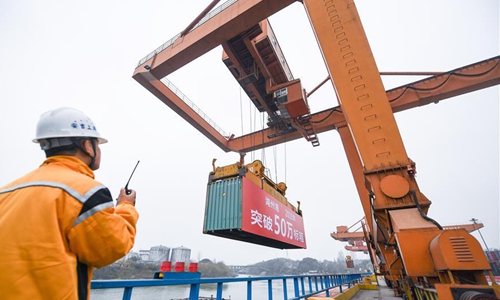When trade war eases, India’s exports to China may increase
By Ding Liping Source:Global Times Published: 2020/1/6 23:38:40

Photo:Xinhua
According to information currently available, China and the US may sign the phase one agreement arising from their trade negotiations. The trade war initiated by the US will be eased.Although trade between China and the US will not return to the original pattern, 2020 will undoubtedly be a crucial year for China to expand its export market and, at the same time, increase its import sources. We have seen that the efforts of Chinese companies have brought positive results. According to official data, the proportion of China's imports and exports with emerging markets increased 1.7 percentage points to 59.5 percent of China's total trade volume in the first 11 months of 2019.
This situation will help India expand its exports to China.
China-India trade has been affected by the trade war during the past year. According to Chinese statistics, from January to September 2019, China-India trade was $69.66 billion, a year-on-year decrease of 3 percent. Breaking the total down, China's exports to India stood at $56.31 billion, a reduction of 2.7 percent, while imports from India were $13.35 billion, down 4.1 percent. India's trade deficit with China reached $42.96 billion. India urgently needs to expand exports to China. It's become a vital issue in bilateral relations.
In terms of Indian exports to China, mineral products, chemical products and textiles are the top three categories. In 2018, India exported $5.03 billion worth of mineral products, $3.63 billion of chemical and $1.84 billion of textiles, and these three products accounted for 63.6 percent of India's exports to China.
China imports many raw materials, mostly for use in manufacturing, which generate a large number of export products. Since the outbreak of the trade war, China's export to the US have been affected by increased tariffs. That in turn has forced Chinese manufacturers to reduce their imports of raw materials from India.
This situation will ease in 2020, primarily as China's efforts to expand export and import diversification improve. In the past year, China's exports to many regions, including Asia, Europe and Africa, have all grown. Therefore, in the foreseeable future, these three types of products will remain China's main imports from India and have the potential to expand.
According to the India-based Economic Times, India may increase the export of 20 products to China, including electrical equipment, aircraft parts, engines and other automotive parts, benzene, frozen boneless beef, and ferroalloys. At present, China's annual import demand for these 20 products may reach $82 billion, while India can only meet 3.3 percent of the total demand, or $2.7 billion. India can significantly reduce its trade deficit with China by exporting more of these items.
India has considerable potential for reducing its trade deficit with China, as we can see from Made-in-China products sold on the Indian market. Most of them are low- and mid-range products. India can make these things itself.
India may need more investment to build factories to make those items, and many Chinese manufacturers have tried to transfer their factories abroad in the past several years. The key is whether India can provide more favorable policies for them. This cooperation will enable Chinese consumers to buy more Indian-made products in the future, just as Vietnam-made shoes are now on the Chinese market.
In the coming year, India should also find ways to attract more foreign direct investment to build its labor-intensive industries and reinforce its connection to the global manufacturing chain. This should be an important policy direction for Indian Prime Minister Narendra Modi's government.
The author is a commentator with the Global Times. bizopinion@globaltimes.com.cn
Posted in: COLUMNISTS,CHINA-INDIA